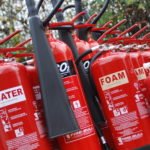A BBC investigation has detailed how post-Grenfell cladding inspections have uncovered a series of other fire risks – many related to compartmentation issues.
Flat owners and tenants have been looking for reassurance that the cladding on their home is safe, ever since the Grenfell Tower fire in June 2017.
But inspections carried out as a result of these fears have revealed that the problems are not just cladding-related.
The BBC reports that ‘Many owners are now finding problems with “compartmentation” – the way their individual flat is sealed to stop fire and smoke spreading within a building.
‘Typically, flats should have barriers inside the spaces between any cladding and the outside walls, and fire breaks in the internal walls to ensure flats are protected for as long as possible should a fire break out.’
According to Façade Remedial Consultants, defective fire safety has been found in 90% of the 2,000 buildings inspected and around 60% of those are not cladding related.
Speaking to IFSEC Global’s sister brand, SHP, about the report, Gill Kernick, Master Consultant at JMJ Associates, who has been a high-profile voice on the subject of the Grenfell Tower fire, said: “Three and a half years after Grenfell, hundreds of thousands are unsafe in their homes and many are being asked to pay extortionate bills for interim safety measures and to remediate their buildings. Until consequences are fairly borne by those responsible for developing, designing, building and maintaining unsafe buildings, there will be little imperative to change.
“A siloed focus on cladding rather than adopting a transparent and holistic-risk assessment and mitigation programme means we do not even know the scale of the problem. This is unforgivable.
“Imagine, for a moment, that your home was clad in material that would burn like Grenfell. Imagine for a moment, putting your children to bed, knowing they are not safe. Imagine facing financial ruin for buying your dream home and now being stuck in a nightmare you can’t get out of. Imagine the impact on your mental health. Imagine not being able to protect your family.
“Speaking and listening to those impacted by this crisis is heart breaking. And their resilience and campaigning for change together with the Grenfell community is inspiring.
“When it comes to leadership of safety, actions speak louder than words. On results alone, the government and the building industry cannot say they are committed to change or provided the level of leadership needed.”
In October, London Fire Brigade announced that there are now 430 buildings on what it calls it’s ‘waking watch’, meaning it makes fortnightly checks on buildings that it deems are ‘potentially unsafe’. That number has risen from 286 in March of this year.
The report comes months after the government announced that the new Fire Safety Bill, fire safety consultation and Building Safety Bill would bring “biggest improvements to building safety in nearly 40 years”.
Access new fire safety expertise by downloading the free Barbour Director's Briefing, and learn how to create a 'carefully devised plan of action' to make your fire strategy more comprehensive than ever. In this free Director’s Briefing, Barbour EHS provides key information relating to the Regulatory Reform (Fire Safety) Order 2005 in England and Wales, including what is required from the responsible person of a property.


Passive fire products do not ‘prevent’ fires. Can the correct terminology not be used in a technical article please? It’s no surprise to me that cavity barriers and/or fire stopping are missing/incomplete from these blocks, when they are missing/incomplete in almost every other building. This is par for the course as we have seen rapid fire spread in Worcester Park, Cheshunt care home and numerous other fairly recent fires. Gill has this spot on with ‘siloed’ focus on single problems.